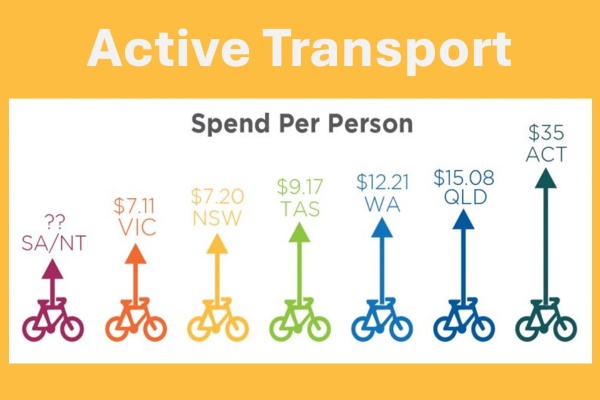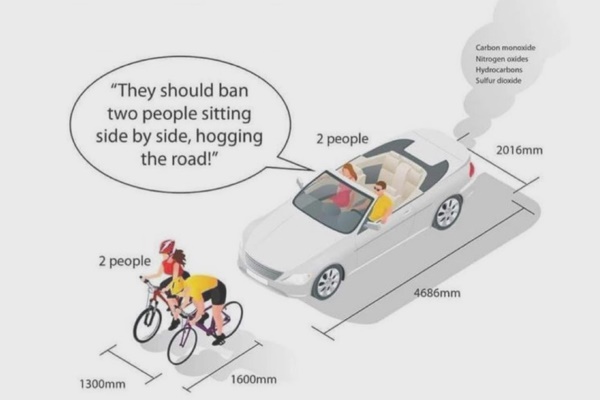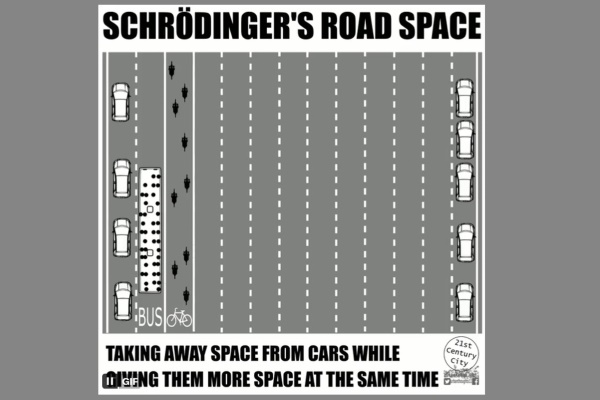Bike paths and pedestrian-friendly streets have much more to do with improving our economy than many people realise!
Pitt Street in the Sydney’s CBD. Originally installed as part of the pop-up cycleways program in response to social distancing rules, the Pitt Street cycleway was made permanent in 2022. Two vehicle lanes were reallocated – one for the cycleway and one to create space for outdoor dining, benches and bike parking. Great streets are good for businesses. And they support climate action, by making it easier for people to embrace zero-carbon mobility options. Changing the world starts by making our streets better. (Image: Bicycle NSW)
We already know that active transport infrastructure benefits business. Yet we are building more roads for more vehicles in the hope that this will stimulate economic growth. Instead, the result is clogged urban roads, poor air quality, sedentary lifestyles, poor and a spiralling road trauma toll.
It is so hard to change the status quo.
As academics from the University of Leeds found: “Research on car dependence exposes the difficulty of moving away from a car-dominated, high-carbon transport system, but neglects the political-economic factors underpinning car-dependent societies.”
(The political economy of car dependence: A systems of provision approach)
And the reluctance of politicians to tackle the issue head on is underpinned by ‘motonormativity'. This term encapsulates how society accepts the risks and harms of car use – when people clearly wouldn’t accept those harms in other facets of life. We are heavily invested in cars after decades of being sold the dream. It is hard to imagine a different future.
‘Storage’ by Dave Walker shines a light on the challenges of reallocating road space for walking, cycling and trees to create Better Streets. Transport for NSW has published policies and strategies that prioritise walking and cycling over the storage of private vehicles but it is still incredibly difficult to have that conversation with a community so accustomed to car-first planning (Image: Dave Walker)
Cycling and walking has a direct economic benefit by:
- decreasing motoring costs
- decreasing traffic congestion
- decreasing infrastructure spending
- improving health
- improving environmental outcomes
- improving urban liveability
Every dollar invested in cycling infrastructure may return up to five dollars’ worth of benefits.
Mostly from the health benefits of promoting a more active lifestyle. This is important in supporting the case for additional funding for cycling infrastructure.
However, funding for active transport does not stack up well
In Australia walking and cycling only receive between 0.1% and 2% of state transport budgets.
These figures were calculated by Bicycle NSW in 2019 and show NSW Lagging Behind the Pack in fifth place with $7.30 budgeted per person for active transport (Image: Bicycle NSW)
And things haven’t got better.
NSW currently only spends 0.2% of its transport budget on active travel which is 100 times below the 20% recommended by the UN.
It will take more than 300 years to deliver healthy streets if we continue spending 0.2% of a $7.67 billion NSW transport budget on active transport
The investment would have to increase at least 100x to achieve the suggested levels of investment on ‘non-motorised transport’.
We are not asking for the Government to spend additional money. But we are requesting a greater proportion to go towards walking and cycling. 10% of the transport budget should ne allocated to active transport over the next four years.
Read our letter to the Premier here
Perpetuating car-centric thinking comes at an unacceptable cost
A continued lack of investment is a reason why only 5% of trips to work in Australia are via walking or cycling. Although a larger number of city trips are short enough to walk or cycle for most of us.
Another clever graphic that highlights how car-first thinking perpetuates inequitable, unsafe streets. (Image: Saboteur Cyclist)
Better streets and bicycle-friendly design can unclog roads and improve traffic congestion with fewer vehicles on the road.
Rather than building more traffic lanes the time has truly come to instead invest in better walking and cycling infrastructure. Perhaps firstly addressing the most dangerous streets to cycle on, as reported by BikeSpot recently!
Children who live within 800m of their school are more likely to walk or cycle to school
Register now for the Bicycle NSW Ride To School Program so we can support your school community as our school active transport projects ramp up in 2024. (Image: National Heart Foundation)
Building more paths not roads
Building more roads and traffic lanes is depoliticised. It is widely accepted as a way to boost economic growth. Interestingly, driving times and traffic volume may actually increase as a result of building more roads.
People are encouraged to drive more due to ‘induced demand’. Congestion becomes worse – sometimes very quickly.
More than two in three Australians drive to work with the majority having no passengers.
Also more than 50% of car journeys in cities are less than 5kms. These trips would be ideally best for cycling or walking. Better and safer streets, shared paths and cycleways are fundamental to achieving this.
Schrödinger's road space. Check out the animation to see how giving the cars less space creates more space for cars at the same time. As well as parks, plazas and housing. This is the sort of paradox physicist Schrödinger loved! (Image: XXI Century City)
Billions of dollars have been set aside for vehicle lanes and motorway infrastructure to ‘grow out of the COVID-19 recession’. But if we want less traffic congestion we need to invest more of these funds into safer, healthier and happier streetscapes and separated bicycle paths.
Targeted investment in infrastructure to support walking and biking will lead to multiple benefits. Inspiring people out of their vehicles for shorter trips will encourage less driving.
Bicycle NSW has been campaigning for safe, accessible bicycle infrastructure for almost 50 years.
“If you care about the environment, health, cost of living, social equity and childhood independence, consider joining Bicycle NSW and supporting our bike advocacy,” says Bicycle NSW CEO, Peter McLean.







